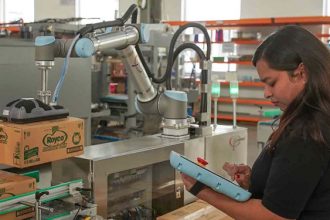Taking A Holistic Approach To Warehouse Resource Optimization Through Software

Access to automation is no longer limited to the largest companies with the biggest budgets. Rather, as innovative technologies such as mobile automated vehicles, robotics, and automated storage and retrieval systems (ASRS) have become more flexible and more affordable, mid-sized companies are now adding them to their arsenal of inventory and fulfillment solutions.
Yet many of these operations have historically been conventional, manual operations, and therefore less adept at ensuring that their new investment is integrated and synchronized with all of their current technologies and systems. As a result, because the existing workflows, equipment, and labor resources are not aligned with the capabilities of the new automation in an overarching, holistic way, facilities managers are often forced to throttle the new technology — because the rest of the operation can’t keep up.
Often, an organization assumes that one (or more) of the many warehouse software systems already in place (or included with the automation technology) will automatically connect every system and optimize the overall operation. Unfortunately, that is rarely the case. Each of alphabet soup of softwares most frequently deployed within warehouses, distribution centers (DCs), and fulfillment centers are actually intended to serve a specific purpose and perform a unique function. These include:
Enterprise Resource Planning (ERP) – A system that manages and integrates day-to-day business processes, such as accounting, procurement, project management, risk management, compliance, and possibly some limited warehouse management capabilities. It is typically connected to an operation’s warehouse management system (WMS).
Warehouse Management System (WMS) – Software that serves as the primary information hub within a warehouse. It provides visibility into inventory and manages/directs all fulfillment operations. A WMS interfaces with an ERP system, as well as with warehouse execution systems (WES), robot workflow management software, and warehouse resource optimization systems (WROS).
Warehouse Execution System (WES) – Software that is primarily deployed in highly automated, complex operations to aid in the prioritization, optimization, and interfacing between manual and automated processes. It connects to both a WMS and a warehouse control system (WCS) to accomplish these tasks.
Robot Workflow Management – Also sometimes called fleet management software, this system assigns material movement tasks to a network of autonomous mobile robots (AMRs) or automatic guided vehicles (AGVs). It interfaces directly with a WMS to schedule and prioritize robotic workflows.
Warehouse Control System (WCS) – This software optimizes inventory movement within a facility by connecting to a material flow control (MFC) system or directly to an automated system controller to manage the equipment’s operation. It connects directly to a WES or WMS.
Material Flow Control (MFC) – A system interface that controls conveyors and other automated equipment to manage transport routing and sequencing. It connects to a WES.
While these separate software systems often link to one another, none of them are designed to tie everything together in a holistic, overarching way. Achieving that goal requires a new type of software, known as a Warehouse Resource Optimization System (WROS). This software optimizes automation, labor, equipment, and space requirements within a warehouse by using intelligent algorithms enhanced by artificial intelligence (AI) to increase efficiencies and improve output.
Adding a WROS to an operation ensures that orders are released in a synchronized, balanced way. Because the WROS has a total view of all aspects of a fulfillment operation, it streamlines and optimizes all available resources.
The most advanced versions of this software apply artificial intelligence (AI) and machine learning (ML) to address the key objective of the operation, typically correctly sequencing and releasing orders based on a variety of service level agreement (SLA) parameters. A WROS utilizes AI to build a pick wave, for example, then uses ML to analyze and improve the process prior to releasing the next wave. This continuous refinement ensures that any manual workflows — receiving, replenishment, picking, packing, shipping and so on — are able to keep pace with the automation.
For more details about how WROS software is helping mid-sized operations make the most of their automation investment — and about other developments in warehouse automation software — connect with the members of MHI’s Solutions Community (which includes a Software Committee). As the industry’s thought leaders on automation, software, hardware, equipment and services, Solutions Community members support a fully integrated supply chain. This includes suppliers, integrators, consultants, media, academia and users. They collaborate on solutions worldwide and in virtually every major manufacturing and distribution sector. To ensure you never miss a post, including more like this one, sign up for the Warehouse Automation newsletter.



